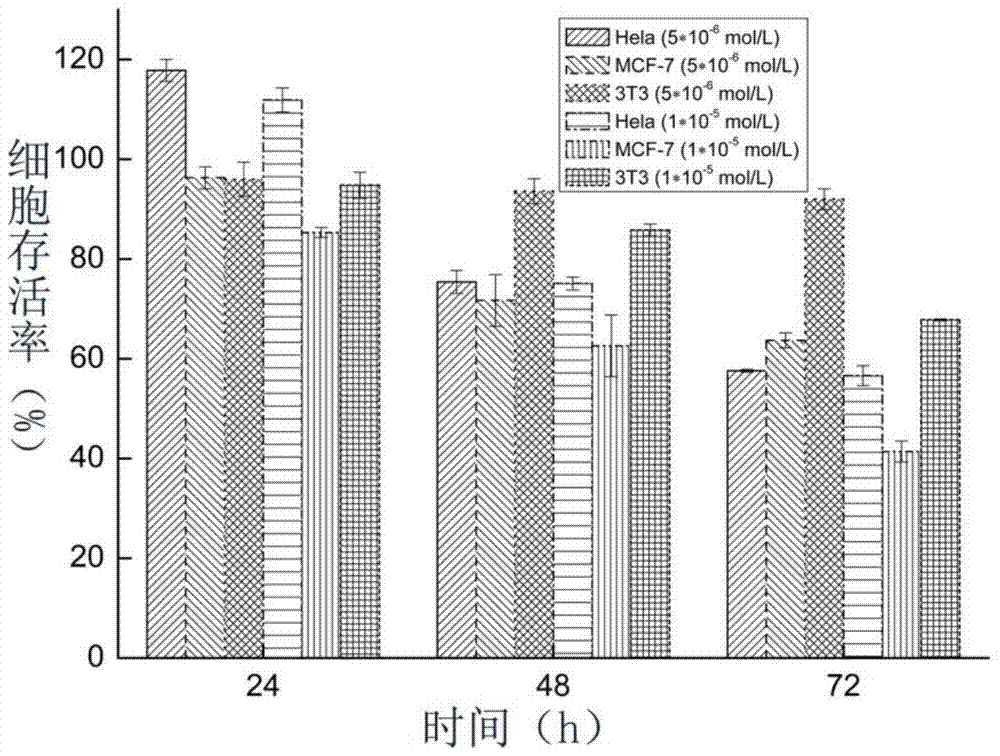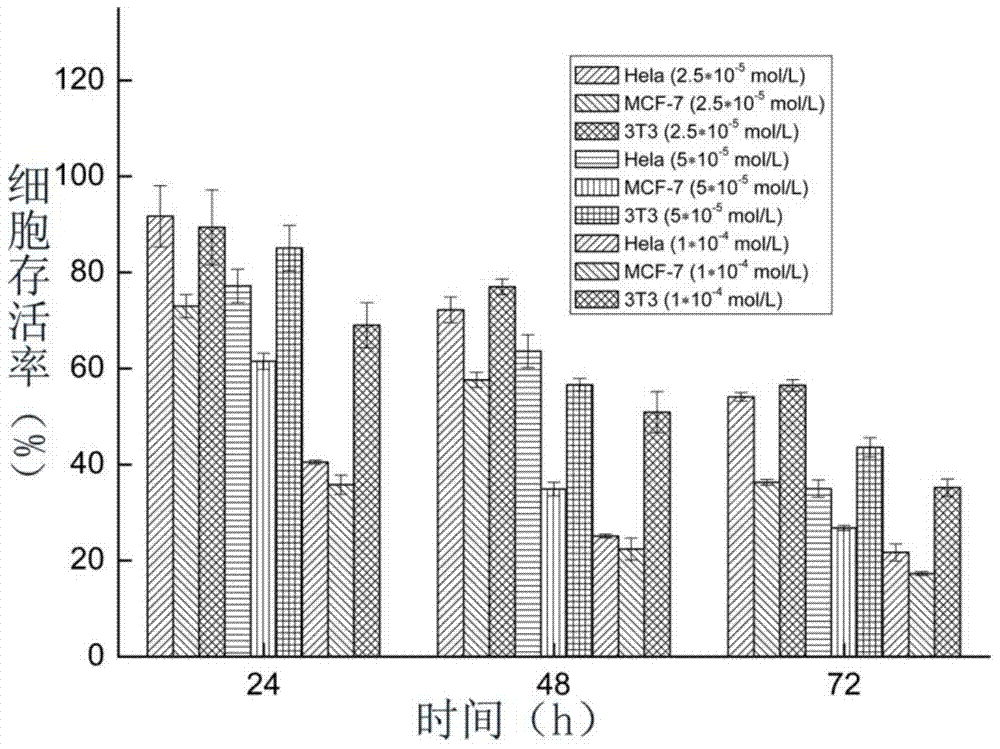Fluorescent probe for targeting detection and cancer cell inhibition and its preparation method and use
A technology of fluorescent probes and cancer cells, which is applied in the field of fluorescent sensors, can solve the problems of lack of targeting, and achieve the effect of simple preparation method and convenient operation
- Summary
- Abstract
- Description
- Claims
- Application Information
AI Technical Summary
Problems solved by technology
Method used
Image
Examples
Embodiment 1
[0063] (1) Weigh palladium chloride (PdCl 2 , 0.1383g), copper bromide (CuBr 2 , 10.4105g) was added to a 250mL round bottom flask, acetonitrile (1.26mL) and toluene (63mL) were added, 4-ethynylbenzaldehyde (2.0g) was slowly added, and the coupling reaction was carried out while stirring at 25°C. Stop the reaction after reacting for 11h, filter the mixture in the flask with a Buchner funnel, and spin the filtrate to obtain the crude reaction product 1. After dissolving the crude product 1 with 5mL chloroform, dissolve the crude product 1 with petroleum ether:dichloromethane=1:1 As eluent, separated by column chromatography and vacuum dried to obtain 4,4'-((1E,3E)-1,4-dibromo-1,3-butadiene-1,4-diyl)diphenyl formaldehyde;
[0064] (2) Weigh 573mg 4-formylphenylboronic acid pinacol ester and add it to a 250mL three-neck flask, add 100mL CaH 2 Dried dichloromethane, sealed with a rubber stopper and passed through N 2 After 30 minutes, add 565 mg of 1,4-dimethylpyrrole, add 0.1...
Embodiment 2
[0074] (1) Weigh palladium chloride (PdCl 2 , 0.1383g), copper bromide (CuBr 2 , 10.4105g) was added to a 250mL round bottom flask, acetonitrile (1.26mL) and toluene (63mL) were added, methyl 4-ethynylbenzoate (2.0g) was added slowly, and the coupling reaction was carried out while stirring at 25°C. Stop the reaction after reacting for 11h, filter the mixture in the flask with a Buchner funnel, and spin the filtrate to obtain the crude reaction product 1. After dissolving the crude product 1 with 5mL chloroform, dissolve the crude product 1 with petroleum ether:dichloromethane=1:1 As eluent, separated by column chromatography and vacuum dried to obtain 4,4'-((1E,3E)-1,4-dibromo-1,3-butadiene-1,4-diyl)diphenyl Methyl formate.
[0075] (2) Weigh 573mg 4-formylphenylboronic acid pinacol ester and add it to a 250mL three-neck flask, add 100mL CaH 2 Dried dichloromethane, sealed with a rubber stopper and passed through N 2 After 30 minutes, add 565 mg of 1,4-dimethylpyrrole, ad...
Embodiment 3
[0085] (1) Weigh 8 mg of DIBODIPY-DICHO prepared in Example 1 and dissolve it in 15 mL of dried N,N-dimethylformamide (DMF), add 8 mg of polypeptide (cc-259 for short, its structure is given by Composed of 11 amino acids, including glycine (Gly), histidine (His), isoleucine (Ile), serine (Ser), valine (Val)), the oil bath was stirred at 30°C for 40 hours, and the air pump was used to directly Blow dry the solvent DMF. The dried product was then dispersed in 5 mL of dimethyl sulfoxide (DMSO) to remove unreacted raw material DIBODIPY-DICHO. Then add 200mL of distilled water thereinto, after stirring evenly, put the mixed solution into a dialysis bag with a molecular weight cut-off of 1000, immerse the dialysis bag in distilled water and let it stand for dialysis for 48 hours, take out the solution in the dialysis bag after dialysis, freeze it with liquid nitrogen, Freeze and vacuum dry in a freeze dryer to obtain solid powder DIBOODIPY-PEPTIDE.
[0086] Among them, the polypep...
PUM
 Login to View More
Login to View More Abstract
Description
Claims
Application Information
 Login to View More
Login to View More - R&D
- Intellectual Property
- Life Sciences
- Materials
- Tech Scout
- Unparalleled Data Quality
- Higher Quality Content
- 60% Fewer Hallucinations
Browse by: Latest US Patents, China's latest patents, Technical Efficacy Thesaurus, Application Domain, Technology Topic, Popular Technical Reports.
© 2025 PatSnap. All rights reserved.Legal|Privacy policy|Modern Slavery Act Transparency Statement|Sitemap|About US| Contact US: help@patsnap.com



